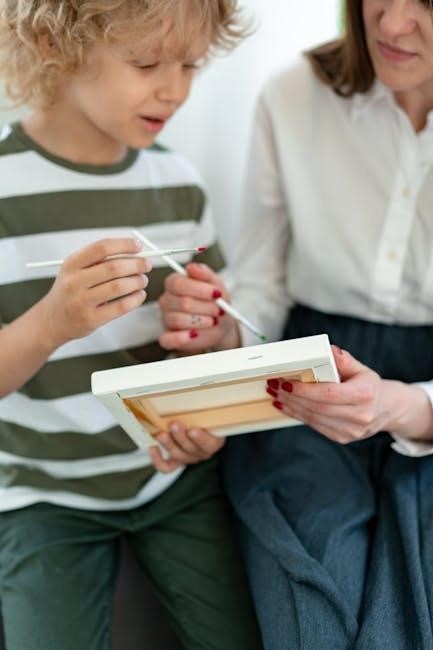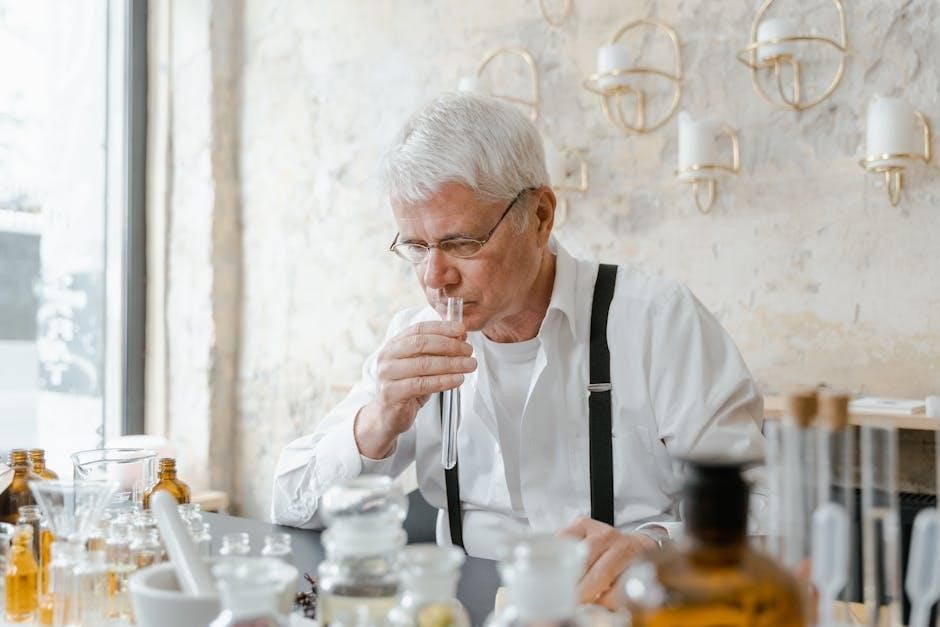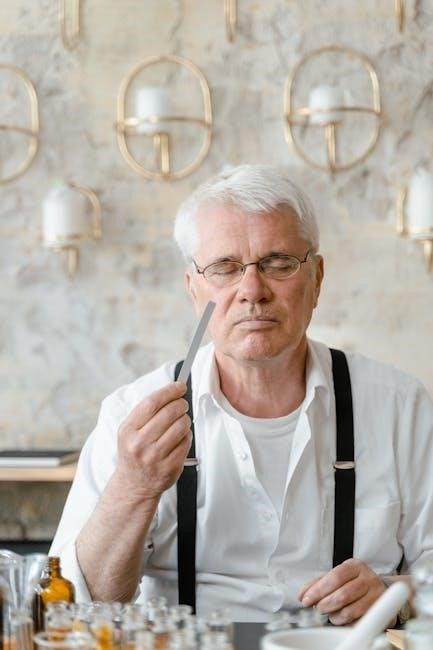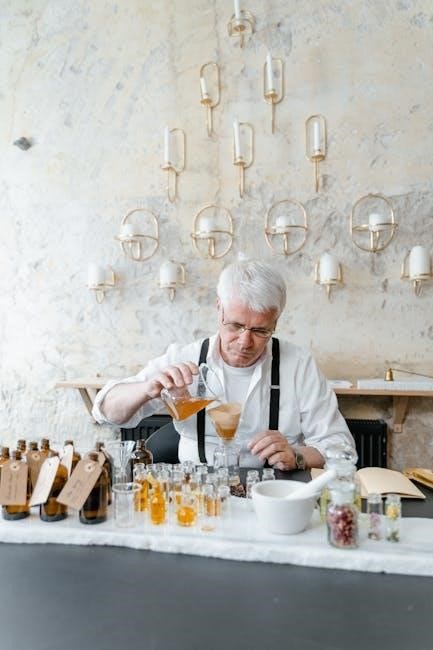Perfume concentration refers to the amount of fragrance oil in a scent, determining its strength and longevity. Higher concentrations mean more oil, resulting in a stronger, longer-lasting aroma. Understanding this helps users choose the right fragrance for their preferences and needs, ensuring optimal performance and satisfaction.
1.1 Understanding Fragrance Concentration

Fragrance concentration refers to the percentage of perfume oil in a scent, which determines its strength and longevity. Higher concentrations, like parfum, contain more oil, offering a richer and longer-lasting aroma. Lower concentrations, such as eau fraiche, have less oil, resulting in a lighter, shorter-lived scent. The balance between oil, alcohol, and water defines the intensity and duration of the fragrance. Understanding this helps users identify how potent a scent will be and how long it will last, guiding their choice for specific occasions or personal preferences.
1.2 Importance of Knowing Perfume Concentrations
Understanding perfume concentrations is essential for selecting the right fragrance for different occasions and personal needs. Higher concentrations, like parfum, last longer and are ideal for special events, while lower ones, such as eau de cologne, are better for everyday use. Knowing the concentration helps determine how often to reapply and ensures the scent behaves as expected. It also aids in budgeting, as higher concentrations may be more expensive but require less frequent use. This knowledge enhances the overall fragrance experience, ensuring satisfaction and value for money.

Types of Perfume Concentrations
Perfume concentrations include Parfum, Eau de Parfum, Eau de Toilette, Eau de Cologne, and Eau Fraiche, each varying in fragrance oil levels and longevity, catering to different preferences and occasions.
2.1 Parfum (Extrait de Parfum)
Parfum, or Extrait de Parfum, is the most concentrated fragrance type, containing 20-40% perfume oil. It offers exceptional longevity, lasting 8-12 hours, making it ideal for special occasions. Due to its high oil concentration, it provides a rich, intense scent and is typically applied sparingly. Parfum is often more expensive than other concentrations because of the large amount of premium fragrance oils used in its composition. This concentration is perfect for those who prefer a strong, long-lasting fragrance and are willing to invest in a luxurious product.
2.2 Eau de Parfum (EDP)
Eau de Parfum (EDP) contains 15-20% fragrance oil, offering a balance between strength and subtlety. It lasts approximately 6-8 hours, making it suitable for both daytime and evening wear. EDP is less concentrated than Parfum but more so than Eau de Toilette, providing a moderate scent projection. Its versatility makes it a popular choice for everyday use, as it is not overly overpowering but still delivers a noticeable aroma. EDP is ideal for those seeking a fragrance that is both long-lasting and elegant, perfect for professional or casual occasions.
2.3 Eau de Toilette (EDT)
Eau de Toilette (EDT) is a lighter fragrance option, typically containing 5-15% perfume oil. It is less concentrated than EDP, offering a fresher and more subtle scent. EDT generally lasts 4-6 hours, making it ideal for everyday use or casual occasions. Its lighter composition makes it suitable for those who prefer a delicate aroma or have sensitive skin. EDT is often chosen for its versatility and is a popular choice for spring and summer due to its crisp, airy quality. It provides a gentle yet noticeable fragrance, perfect for work or daytime activities.
2.4 Eau de Cologne (EDC)
Eau de Cologne (EDC) is a light and refreshing fragrance option, typically containing 2-5% perfume oil. It is less concentrated than Eau de Toilette, offering a subtle and airy scent. EDC generally lasts 2-4 hours, making it ideal for casual, everyday use or as a quick refresh. Often used as an aftershave, it is perfect for spring and summer due to its crisp, citrus-based notes. Its light composition makes it suitable for those who prefer a gentle aroma without overpowering strength. EDC is a classic choice for its invigorating and fresh appeal.
2.5 Eau Fraiche
Eau Fraiche is the least concentrated fragrance, typically containing 1-3% perfume oil. It is water-based, without alcohol, making it gentle on the skin. This light, refreshing option lasts about 1-2 hours, ideal for warm weather or daytime use. Eau Fraiche is perfect for those who prefer a subtle scent or have sensitive skin. Its delicate nature makes it a great choice for layering or as a quick pick-me-up. However, its short longevity means reapplication may be necessary throughout the day for a lasting effect.

Key Characteristics of Each Concentration
Each perfume concentration has unique traits, such as longevity, strength, and optimal usage time. Higher concentrations like Parfum last longer (8-12 hours) and are ideal for evening wear, while lighter ones like Eau Fraiche are refreshing but fleeting. Understanding these characteristics helps in selecting the right fragrance for specific occasions, ensuring a balanced and appealing scent experience throughout the day or night.
3.1 Longevity and Strength
Longevity and strength are key factors in perfume concentrations. Parfum (15-25%) lasts 8-12 hours, offering a rich, intense scent. Eau de Parfum (15-20%) lasts 6-8 hours, with a balanced aroma. Eau de Toilette (5-15%) lasts 4-6 hours, providing a lighter, fresher fragrance. Eau de Cologne (2-5%) and Eau Fraiche (1-3%) last 2-4 hours, ideal for everyday use. Higher concentrations have more fragrance oil, resulting in stronger scents that linger longer. Understanding these differences helps in selecting the right concentration for personal preferences and occasions, ensuring the desired impact and duration of the fragrance.
3;2 Oil Concentration Levels
Oil concentration levels vary significantly across perfume types. Parfum contains 20-40% fragrance oils, offering intense scents. Eau de Parfum has 15-25%, balancing strength and longevity. Eau de Toilette ranges from 5-15%, providing lighter aromas. Eau de Cologne and Eau Fraiche have the lowest concentrations, at 2-5% and 1-3%, respectively. Higher oil levels result in stronger, longer-lasting fragrances. Understanding these concentrations helps in selecting the perfect scent based on personal preferences and the desired intensity of the fragrance. Each level caters to different needs, ensuring the right balance of potency and duration.
3.3 Best Time and Occasion for Use
Choosing the right perfume concentration for the occasion enhances its impact. Parfum and Eau de Parfum are ideal for evening events or special occasions due to their rich, long-lasting scents. Eau de Toilette is perfect for everyday wear, offering a subtle aroma. Eau de Cologne and Eau Fraiche are refreshing choices for casual, daytime use or during warmer seasons. Seasonal variations also play a role; lighter concentrations suit summer, while stronger ones are better for winter. Matching the concentration to the time and occasion ensures the fragrance is appreciated and effective.

How to Choose the Right Concentration

Selecting the right perfume concentration involves considering skin type, personal preference, and occasion. Higher concentrations suit those who want longevity, while lighter options are ideal for everyday use. Budget and seasonal preferences also influence the choice, ensuring the fragrance meets individual needs effectively.
4.1 Skin Type and Personal Preference
Your skin type and personal preference play a crucial role in selecting the right perfume concentration. For instance, those with sensitive skin may find lower concentrations like Eau de Toilette or Eau Fraiche more suitable, as they contain less alcohol and are gentler. On the other hand, individuals with oily skin might prefer higher concentrations like Parfum or Eau de Parfum, as these last longer and provide a more intense scent. Personal preference also dictates whether you enjoy a subtle, all-day fragrance or a bold, evening scent. Additionally, some people may prefer lighter concentrations for everyday use, while reserving stronger ones for special occasions. It’s important to test different concentrations on your skin to see how they react and linger throughout the day. This ensures you find a fragrance that complements your skin and aligns with your personal style, creating a lasting impression without causing discomfort or fading too quickly. By considering both skin type and personal taste, you can make an informed decision that enhances your daily fragrance experience.
4.2 Seasonal Variations
Seasonal variations play a significant role in choosing the right perfume concentration. Lighter concentrations like Eau de Toilette or Eau de Cologne are ideal for summer, as they are refreshing and less overpowering in warmer weather. In contrast, richer concentrations such as Eau de Parfum or Parfum are better suited for winter, offering longer-lasting scents that complement colder climates. Additionally, spring and autumn call for balanced options like Eau de Parfum, which provides a moderate strength suitable for transitional weather. Considering the season ensures your fragrance remains appropriate and enjoyable, aligning with the environment and your activities.
4.3 Budget Considerations
Budget considerations significantly influence perfume choices. Higher concentrations like Parfum and Eau de Parfum, containing more fragrance oil, are typically more expensive but last longer, reducing the need for frequent reapplication. Eau de Toilette and Eau de Cologne, with lower concentrations, are more affordable but may require reapplication throughout the day. Balancing budget with preference and longevity helps consumers make cost-effective decisions. Understanding concentration levels allows shoppers to prioritize their spending, ensuring they find a fragrance that fits both their budget and lifestyle without compromising on quality or personal satisfaction.
Application Tips for Different Concentrations
Apply higher concentrations like Parfum sparingly, while lighter ones like Eau de Toilette can be used more liberally. Layering fragrances enhances longevity and depth of scent.
5.1 Applying Parfum and Eau de Parfum
Parfum and Eau de Parfum are rich, so apply them sparingly to pulse points like wrists, behind the ears, and the base of the neck. These areas emit body heat, enhancing the fragrance. For Parfum, a small dab is enough due to its high concentration. Eau de Parfum can be applied slightly more generously but still in moderation. Avoid over-application, as these concentrations are potent and designed to last. Applying them in the morning or evening ensures a long-lasting, intimate scent perfect for close encounters or special occasions.
5.2 Applying Eau de Toilette and Eau de Cologne
Eau de Toilette and Eau de Cologne are lighter concentrations, making them ideal for everyday use. Apply them liberally to pulse points such as wrists, neck, and behind the ears. Their lower fragrance oil content means they may require reapplication throughout the day to maintain the scent. Eau de Cologne, being even lighter, can be applied more generously, especially after shaving or as a refreshing splash. These concentrations are perfect for casual occasions or warm weather, as they provide a subtle yet fresh aroma that doesn’t overwhelm. Reapply as needed to keep the scent vibrant and enjoyable.

5.3 Layering Fragrances for Longer Lasting Scent
Layering fragrances is a technique to enhance longevity and depth. Start with a fragrant shower gel or body lotion, then apply a concentrated perfume oil to pulse points. Follow with an Eau de Parfum or Eau de Toilette spray over the oil. This method creates a layered effect, where each product complements the others, ensuring a richer and longer-lasting scent. Additionally, using matching ancillaries like deodorants or hair mists can amplify the fragrance. Experiment with different combinations to find the perfect blend that suits your personal style and extends the life of your perfume throughout the day.
Understanding perfume concentrations is key to selecting the perfect fragrance. Higher concentrations offer longevity, while lighter ones provide freshness. Choose based on personal preference, occasion, and lifestyle for a tailored scent experience that lasts.

6.1 Summary of Key Points
Perfume concentrations vary from high to low, with Parfum being the most potent and Eau Fraiche the lightest. Each type differs in fragrance oil percentage, longevity, and strength. Higher concentrations last longer but may not project as much, while lighter ones are fresher but fade faster. Skin type, personal preference, and occasion play significant roles in choosing the right concentration. Understanding these factors helps in selecting a fragrance that suits individual needs and ensures a pleasant, long-lasting scent experience. This guide provides a clear roadmap to making informed decisions when selecting perfumes.
6.2 Final Tips for Choosing the Perfect Fragrance
When selecting a fragrance, consider your lifestyle, skin type, and preferences. Test perfumes on your skin to gauge longevity and projection. Opt for higher concentrations like Parfum or Eau de Parfum for special occasions and lower ones like Eau de Toilette or Eau de Cologne for everyday use. Layering fragrances can enhance longevity. Budget is also a key factor, as higher concentrations are generally more expensive. Ultimately, choose a scent that resonates with you and suits your lifestyle for the best experience. This guide helps you make informed decisions tailored to your needs.
